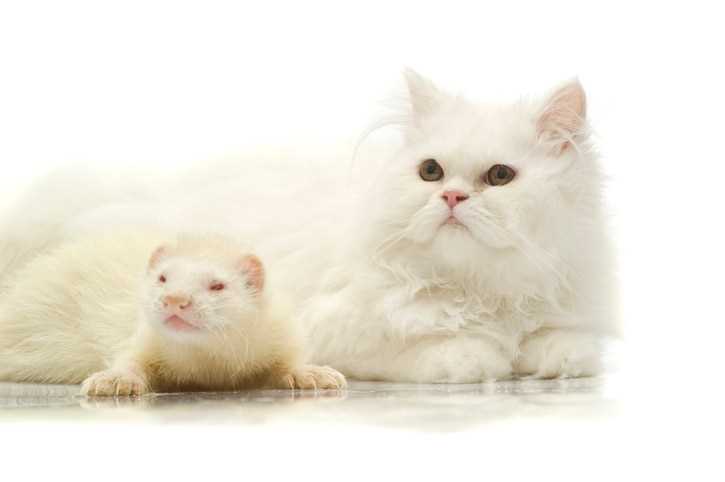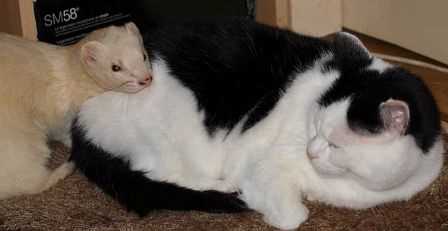



Absolutely, introducing a small mammal to your feline companion can be successful if approached correctly. The key lies in gradual introductions and monitoring their interactions closely. Each animal has its own personality, so some may adapt better than others.
Start by keeping them in separate spaces initially. Let them explore each other’s scents through barriers like baby gates or closed doors. Gradually allow short, supervised meetings in a neutral area. Always be ready to separate them if tensions arise.
Providing safe spaces for both animals is crucial. Ensure your feline has elevated areas to retreat to, while the small mammal should have tunnels or hideaways. This way, both can feel secure and avoid stress during initial encounters.
Consistency and patience are essential. Regularly monitor their behavior and adjust the process as needed. With positive reinforcement, treats, and gentle guidance, they can develop a friendly relationship over time.
Living Together
Sharing space isn’t just about cohabitation; it requires understanding and careful management. My experience indicates that introducing a small, furry companion into a household where a feline resides can be successful, but it demands preparation.
Start by ensuring both parties have their own territory. A separate area for the newcomer is crucial. This allows for gradual introductions, minimizing stress. Scent swapping can help them become familiar with each other’s presence without direct interaction. Use bedding or toys to facilitate this process.
Supervised meetings are essential. Keep initial encounters short and controlled. Observe body language closely; signs of aggression or fear must be addressed immediately. It’s vital to reward calm behavior with treats and praise, reinforcing positive associations.
Safety measures should be taken. Small animals are naturally curious, so secure spaces and remove any potential hazards. Create a safe zone where either can retreat if they feel threatened. This sanctuary can alleviate tension during the adjustment phase.
Regular playtime and mental stimulation are beneficial for both. Engaging activities can reduce territorial instincts and help them bond. Interactive toys can keep them occupied and encourage positive interactions.
Monitor their interactions over time. If any negative behaviors persist, reassess the situation and consider consulting a veterinarian or animal behaviorist for guidance. Patience and consistency are key in fostering harmony.
Assessing the Compatibility of Ferrets and Cats in a Shared Home

Introducing a small weasel-like creature into my territory requires careful evaluation. Here are important aspects to consider for a harmonious coexistence.
Temperament and Behavior

- Observe each personality. My fellow feline friends vary in temperament. Some are playful, while others prefer solitude.
- Young critters often exhibit high energy, which might be overwhelming for a more reserved cat. Monitor interactions closely.
- Establish safe spaces. Both parties should have areas where they can retreat if feeling stressed.
Safety and Supervision
- Always supervise initial meetings. This allows for safe interactions and reduces the chance of misunderstandings.
- Consider the size difference. My kind can be larger and more intimidating, which may scare a smaller companion.
- Use barriers if necessary. Baby gates or separate rooms can help ease into shared living.
Gradual introductions and consistent monitoring ensure that everyone feels secure and comfortable. Keep an eye on body language; it communicates a lot about how each creature feels in the presence of the other.
Steps to Introduce Ferrets to Cats Safely
First, set up a neutral space where the two can meet. Utilize a room that neither of us considers territory. This minimizes stress and territorial behavior.
Gradual Introduction
Begin with short, supervised sessions. Allow brief interactions, gradually increasing the time as comfort levels rise. Observe body language closely; signs of aggression or fear should prompt an immediate separation.
Scent Exchange
Before the initial meeting, exchange bedding or toys between us. This allows familiarization with each other’s scent without direct contact. It eases anxiety during face-to-face interactions.
Provide separate feeding areas. Ensuring each of us has our own space during meals prevents food guarding and territorial disputes. Regularly check both feeding spots, especially if pests are a concern. For tips on keeping our food safe from ants, check out how to prevent ants from cat food.
Monitor behavior closely. If one of us shows stress or discomfort, give it time before the next introduction attempt. Patience is key.
Lastly, maintain ongoing interactions. After initial introductions, continue to supervise and allow playtime as confidence builds. This fosters a positive relationship and reduces future conflicts.
For additional pet care tips, like how to treat a cat with dry skin, feel free to browse my site!
Absolutely, introducing a small mammal to your feline companion can be successful if approached correctly. The key lies in gradual introductions and monitoring their interactions closely. Each animal has its own personality, so some may adapt better than others.
Start by keeping them in separate spaces initially. Let them explore each other’s scents through barriers like baby gates or closed doors. Gradually allow short, supervised meetings in a neutral area. Always be ready to separate them if tensions arise.
Providing safe spaces for both animals is crucial. Ensure your feline has elevated areas to retreat to, while the small mammal should have tunnels or hideaways. This way, both can feel secure and avoid stress during initial encounters.
Consistency and patience are essential. Regularly monitor their behavior and adjust the process as needed. With positive reinforcement, treats, and gentle guidance, they can develop a friendly relationship over time.
Living Together
Sharing space isn’t just about cohabitation; it requires understanding and careful management. My experience indicates that introducing a small, furry companion into a household where a feline resides can be successful, but it demands preparation.
Start by ensuring both parties have their own territory. A separate area for the newcomer is crucial. This allows for gradual introductions, minimizing stress. Scent swapping can help them become familiar with each other’s presence without direct interaction. Use bedding or toys to facilitate this process.
Supervised meetings are essential. Keep initial encounters short and controlled. Observe body language closely; signs of aggression or fear must be addressed immediately. It’s vital to reward calm behavior with treats and praise, reinforcing positive associations.
Safety measures should be taken. Small animals are naturally curious, so secure spaces and remove any potential hazards. Create a safe zone where either can retreat if they feel threatened. This sanctuary can alleviate tension during the adjustment phase.
Regular playtime and mental stimulation are beneficial for both. Engaging activities can reduce territorial instincts and help them bond. Interactive toys can keep them occupied and encourage positive interactions.
Monitor their interactions over time. If any negative behaviors persist, reassess the situation and consider consulting a veterinarian or animal behaviorist for guidance. Patience and consistency are key in fostering harmony.
Assessing the Compatibility of Ferrets and Cats in a Shared Home

Introducing a small weasel-like creature into my territory requires careful evaluation. Here are important aspects to consider for a harmonious coexistence.
Temperament and Behavior

- Observe each personality. My fellow feline friends vary in temperament. Some are playful, while others prefer solitude.
- Young critters often exhibit high energy, which might be overwhelming for a more reserved cat. Monitor interactions closely.
- Establish safe spaces. Both parties should have areas where they can retreat if feeling stressed.
Safety and Supervision
- Always supervise initial meetings. This allows for safe interactions and reduces the chance of misunderstandings.
- Consider the size difference. My kind can be larger and more intimidating, which may scare a smaller companion.
- Use barriers if necessary. Baby gates or separate rooms can help ease into shared living.
Gradual introductions and consistent monitoring ensure that everyone feels secure and comfortable. Keep an eye on body language; it communicates a lot about how each creature feels in the presence of the other.
Steps to Introduce Ferrets to Cats Safely
First, set up a neutral space where the two can meet. Utilize a room that neither of us considers territory. This minimizes stress and territorial behavior.
Gradual Introduction
Begin with short, supervised sessions. Allow brief interactions, gradually increasing the time as comfort levels rise. Observe body language closely; signs of aggression or fear should prompt an immediate separation.
Scent Exchange
Before the initial meeting, exchange bedding or toys between us. This allows familiarization with each other’s scent without direct contact. It eases anxiety during face-to-face interactions.
Provide separate feeding areas. Ensuring each of us has our own space during meals prevents food guarding and territorial disputes. Regularly check both feeding spots, especially if pests are a concern. For tips on keeping our food safe from ants, check out how to prevent ants from cat food.
Monitor behavior closely. If one of us shows stress or discomfort, give it time before the next introduction attempt. Patience is key.
Lastly, maintain ongoing interactions. After initial introductions, continue to supervise and allow playtime as confidence builds. This fosters a positive relationship and reduces future conflicts.
For additional pet care tips, like how to treat a cat with dry skin, feel free to browse my site!
Absolutely, introducing a small mammal to your feline companion can be successful if approached correctly. The key lies in gradual introductions and monitoring their interactions closely. Each animal has its own personality, so some may adapt better than others.
Start by keeping them in separate spaces initially. Let them explore each other’s scents through barriers like baby gates or closed doors. Gradually allow short, supervised meetings in a neutral area. Always be ready to separate them if tensions arise.
Providing safe spaces for both animals is crucial. Ensure your feline has elevated areas to retreat to, while the small mammal should have tunnels or hideaways. This way, both can feel secure and avoid stress during initial encounters.
Consistency and patience are essential. Regularly monitor their behavior and adjust the process as needed. With positive reinforcement, treats, and gentle guidance, they can develop a friendly relationship over time.
Living Together
Sharing space isn’t just about cohabitation; it requires understanding and careful management. My experience indicates that introducing a small, furry companion into a household where a feline resides can be successful, but it demands preparation.
Start by ensuring both parties have their own territory. A separate area for the newcomer is crucial. This allows for gradual introductions, minimizing stress. Scent swapping can help them become familiar with each other’s presence without direct interaction. Use bedding or toys to facilitate this process.
Supervised meetings are essential. Keep initial encounters short and controlled. Observe body language closely; signs of aggression or fear must be addressed immediately. It’s vital to reward calm behavior with treats and praise, reinforcing positive associations.
Safety measures should be taken. Small animals are naturally curious, so secure spaces and remove any potential hazards. Create a safe zone where either can retreat if they feel threatened. This sanctuary can alleviate tension during the adjustment phase.
Regular playtime and mental stimulation are beneficial for both. Engaging activities can reduce territorial instincts and help them bond. Interactive toys can keep them occupied and encourage positive interactions.
Monitor their interactions over time. If any negative behaviors persist, reassess the situation and consider consulting a veterinarian or animal behaviorist for guidance. Patience and consistency are key in fostering harmony.
Assessing the Compatibility of Ferrets and Cats in a Shared Home

Introducing a small weasel-like creature into my territory requires careful evaluation. Here are important aspects to consider for a harmonious coexistence.
Temperament and Behavior

- Observe each personality. My fellow feline friends vary in temperament. Some are playful, while others prefer solitude.
- Young critters often exhibit high energy, which might be overwhelming for a more reserved cat. Monitor interactions closely.
- Establish safe spaces. Both parties should have areas where they can retreat if feeling stressed.
Safety and Supervision
- Always supervise initial meetings. This allows for safe interactions and reduces the chance of misunderstandings.
- Consider the size difference. My kind can be larger and more intimidating, which may scare a smaller companion.
- Use barriers if necessary. Baby gates or separate rooms can help ease into shared living.
Gradual introductions and consistent monitoring ensure that everyone feels secure and comfortable. Keep an eye on body language; it communicates a lot about how each creature feels in the presence of the other.
Steps to Introduce Ferrets to Cats Safely
First, set up a neutral space where the two can meet. Utilize a room that neither of us considers territory. This minimizes stress and territorial behavior.
Gradual Introduction
Begin with short, supervised sessions. Allow brief interactions, gradually increasing the time as comfort levels rise. Observe body language closely; signs of aggression or fear should prompt an immediate separation.
Scent Exchange
Before the initial meeting, exchange bedding or toys between us. This allows familiarization with each other’s scent without direct contact. It eases anxiety during face-to-face interactions.
Provide separate feeding areas. Ensuring each of us has our own space during meals prevents food guarding and territorial disputes. Regularly check both feeding spots, especially if pests are a concern. For tips on keeping our food safe from ants, check out how to prevent ants from cat food.
Monitor behavior closely. If one of us shows stress or discomfort, give it time before the next introduction attempt. Patience is key.
Lastly, maintain ongoing interactions. After initial introductions, continue to supervise and allow playtime as confidence builds. This fosters a positive relationship and reduces future conflicts.
For additional pet care tips, like how to treat a cat with dry skin, feel free to browse my site!









